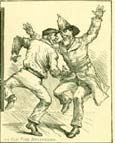
Colonial Firefighting

"The Old New York
Fire Dept Celebration"
Harper's Weekly, 1885
In Peter Stuyvesant’s New Amsterdam, various fire protection measures were created. Criteria were established for new buildings with fire prevention in mind, such as no wooden chimneys. A position of Firemaster was created to policy the fire rules. All citizens were expected to assist in fighting fires once they broke out, but Stuyvesant was interested in preventing fires as much as possible. Fire buckets, ladder and hooks were strategically placed around the city for use and he recruited eight men to patrol the streets for fire. The night watch was eventually expanded to fifty men. When the British took over control of the city, they created a paid position of fire warden whose jobs it was to inspect chimneys in private residences.
When fire broke out in the city, an alarm was sounded, citizens threw their fire buckets to the street, other citizens headed for the fire and brought the fire buckets while citizens lined up some to pass full buckets of water from a river or well and others to pass back empty buckets. After the fire was extinguished, the fire buckets were returned to City Hall were citizens came to retrieve their buckets. By the 1730s, fire protection methods had not grown in relation to the growth of the city and were primitive by the standards of the day. The old system promoting a sense of civic duty but was an increasingly ineffective system.